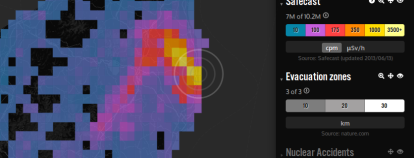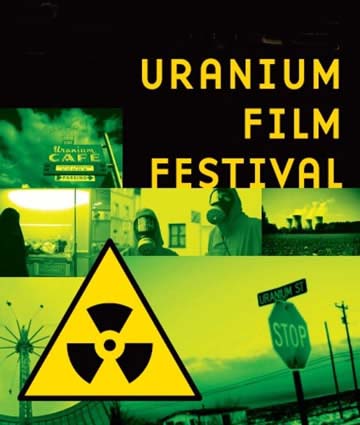IAEA Delivers “Final” Report on Remediation in Fukushima to Japan
The team recognized the efforts to reduce residual doses to less than 1 mSv per year, but stressed that this target is a long-term goal, and that it cannot be achieved in a short time – for example, through decontamination work alone. The IAEA is ready to continue to support Japan in its remediation efforts, at its request.
[…]
Japanese authorities were encouraged to sustain current public communication efforts and enhance these whenever necessary, especially with a view to explaining to the public that, in remediation situations, any level of individual radiation dose in the range of 1 to 20 mSv per year is acceptable and in line with the international standards and with the recommendations from the relevant international organisations such as ICRP, IAEA, UNSCEAR and WHO. http://www.iaea.org/newscenter/news/2014/report-on-remediation.html
Above the IAEA report map and below the safecast map
Japan Herald (IANS) Friday 24th January, 2014
http://www.japanherald.com/index.php/sid/219857386/scat/c4f2dd8ca8c78044/pp/2
The International Atomic Energy Agency (IAEA) Friday handed Japan the final report from an expert mission that reviewed remediation efforts in areas affected by the Fukushima Daiichi nuclear power plant accident.
The IAEA report, which is available online, describes the findings of the Follow-up IAEA International Mission on Remediation of Large Contaminated Areas Off-Site the Fukushima Daiichi Nuclear Power Plant, held Oct 14-21, 2013.
The plant was severely damaged by the March 11, 2011, earthquake-triggered tsunami.
The report highlights important progress in all areas to date, and offers advice on several points where the team feels it is still possible to further improve current practices.
“The mission team was impressed by the amount of resources allocated and by the intense work that Japan is carrying out in efforts to remediate the affected areas and promote the return of evacuees to their homes, together with efforts for reconstruction of those areas,” said Juan Carlos Lentijo, director of IAEA’s fuel cycle and waste technology division.
Lentijo led the 16-member mission team, which comprised international experts and IAEA staff working across a range of disciplines including radiation protection, remediation approaches and technologies, waste management and stakeholder involvement.
Lentijo led the 16-member mission team, which comprised international experts and IAEA staff working across a range of disciplines including radiation protection, remediation approaches and technologies, waste management and stakeholder involvement.
The team welcomed progress achieved following the first IAEA remediation mission in October 2011, including the remediation of farmland and forest areas.
The team also welcomed significant progress by municipalities and the national government in the development and establishment of temporary storage facilities for contaminated materials generated by on-going remediation activities.
In addition, the mission team noted the progress made towards the national government’s creation of interim storage facilities, with the cooperation of municipalities and local communities.
The mission observed that comprehensive implementation of food safety measures is in place to protect consumers and improve consumer confidence in farm produce, reflected in an increase in the economic value of the crops.
–IANS/WAM
– See more at: http://www.japanherald.com/index.php/sid/219857386/scat/c4f2dd8ca8c78044/pp/2#sthash.4LeqqYjY.dpuf
No comments yet.
-
Archives
- April 2024 (343)
- March 2024 (335)
- February 2024 (345)
- January 2024 (375)
- December 2023 (333)
- November 2023 (342)
- October 2023 (366)
- September 2023 (353)
- August 2023 (356)
- July 2023 (363)
- June 2023 (324)
- May 2023 (344)
-
Categories
- 1
- 1 NUCLEAR ISSUES
- business and costs
- climate change
- culture and arts
- ENERGY
- environment
- health
- history
- indigenous issues
- Legal
- marketing of nuclear
- media
- opposition to nuclear
- PERSONAL STORIES
- politics
- politics international
- Religion and ethics
- safety
- secrets,lies and civil liberties
- spinbuster
- technology
- Uranium
- wastes
- weapons and war
- Women
- 2 WORLD
- ACTION
- AFRICA
- Atrocities
- AUSTRALIA
- Christina's notes
- Christina's themes
- culture and arts
- Fuk 2022
- Fuk 2023
- Fukushima 2017
- Fukushima 2018
- fukushima 2019
- Fukushima 2020
- Fukushima 2021
- general
- global warming
- Humour (God we need it)
- Nuclear
- RARE EARTHS
- Reference
- resources – print
- Resources -audiovicual
- World
- World Nuclear
- YouTube
-
RSS
Entries RSS
Comments RSS





Leave a comment